- Discussion:
- considerations for graft placement
- optimal graft angle
- land marks for graft entry point
- determination of graft length
- retention of remnant ligament:
- ref: Anterior cruciate ligament reconstruction with remnant preservation: a prospective, randomized controlled study.
- Transtibial Technique: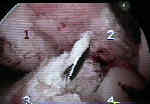
- tibial tunnel guide is inserted and appropriate landmarks for graft placement are established;
- initial guide pin placement and visualization for femoral tunnel;
- note that once guide pin is in place, visualize the angulation toward the femoral tunnel (using transtibial technique);
- if the tibial tunnel is too anterior or the angle is too vertical, then the tibial tunnel may not allow for optional femoral tunnel position;
- ref: Posterior tibial tunnel placement to avoid anterior cruciate ligament graft impingement by the intercondylar roof. An in vitro and in vivo study.
- more medial starting point for tibial tunnel, may allow for better alignment of femoral tunnel;
- triangulation through the medial portal:
- pass the arthroscopic probe thru the medial portal and apply to the edge of the posterior aspect of the intercondylar notch;
- visualize the triangulation between the transtibial guide pin and the arthroscopic probe;
- consider more medial positioning of the transtibial guide pin based on its position relative to the arthroscopic probe;
- references:
- The Relationship Between Femoral Tunnels Created by the Transtibial, Anteromedial Portal, and Outside-In Techniques and the Anterior Cruciate Ligament Footprint.
- Biomechanical evaluation of knee joint laxities and graft forces after anterior cruciate ligament reconstruction by anteromedial portal, outside-in, and transtibial techniques.
- Can anatomic femoral tunnel placement be achieved using a transtibial technique for hamstring anterior cruciate ligament reconstruction?
- The effects of extra-articular starting point and transtibial femoral drilling on the intra-articular aperture of the tibial tunnel in ACL reconstruction.
- appropriately sized drill is then driven over the guide wire (dont shear the guide wire);
- initial impingement check:
- leave the drill 1 cm protruding into the joint and slowly extend the knee;
- this will give an indication of whether residual notch impingement is present;
- if impingement is still present, then additional notchplasty can be performed and the tibial interference screw can be placed anterior to the tibial bone
plug (which moves the graft slightly posteriorly);
- chamfer the tunnel:
- a curet & a shaver may be used to facilitate passage of graft at the articular entrance, and inaddition this chamfering helps prevent tendon
graft fraying on the articular surface;
- following drilling of the tibial tunnel, remove surrounding tissue which may complicate graft passage;
- remnant ACL ligament:
- ref: Preservation of Remnant Attachment Improves Graft Healing in a Rabbit Model of Anterior Cruciate Ligament Reconstruction
- final notchplasty check:
- shut off the inflow cannula, and insert the scope thru the tibial tunnel;
- directly observe the femoral condyle and the notch as the knee is taken thru a full range of motion and ensure that there is no bony impingement;
- advance the reaming drill 1 cm into the notch inorder to determine whether there is residual impingement w/ flexion and extension;
- references:
- Failure of reconstruction of the anterior cruciate ligament due to impingment by the intercondylar roof.
- Roofplasty requirements in vitro for different tibial hole placements in anterior cruciate ligament reconstruction
- The effects of tibial tunnel placement and roofplasty on reconstructed anterior cruciate ligament knees.
- Effect of Femoral Socket Position on Graft Impingement After Anterior Cruciate Ligament Reconstruction
- Graft Fixation: (usually the last step in the case);
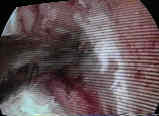
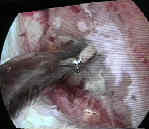
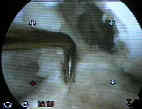
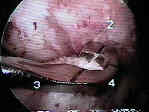
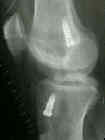
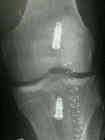 - Post Operative Radiographs:
- Post Operative Radiographs: - on a hyper-extension lateral, the tibial tunnel should remain posterior to Blumenstat's line;
- often Blumenstat's line lies just anterior to a point that bisects the tibia;
- other authors strive to place the tunnel in the anterior half of the middle third of the tibial plateu;
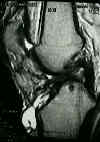 - Complications:
- Complications:
- Tibial Tunnel Syndrome:
- tibial tunnel may enlarge following ACL reconstructive surgery;
- over a one year period the tibial tunnel may increase in diameter by 2 mm (average) over one year
- References:
Definitive landmarks for reproducible tibial tunnel placement in anterior cruciate ligament reconstruction.
Tibial tunnel placement in anterior cruciate ligament reconstruction and graft impingement.
Tibial tunnel placement in ACL reconstruction.
Anterior cruciate ligament reconstruction. The effect of tibial tunnel placement on range of motion.
- Graft Fixation:
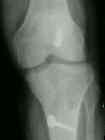
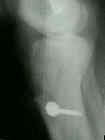
- graft fixation:
- tying over a post:
- tying over a post is often used as a salvage technique (when bone plug interference fixation has failed);
- main disadvantage is that this type of fixation is less stiff, since a longer graft length will undergo more strain

